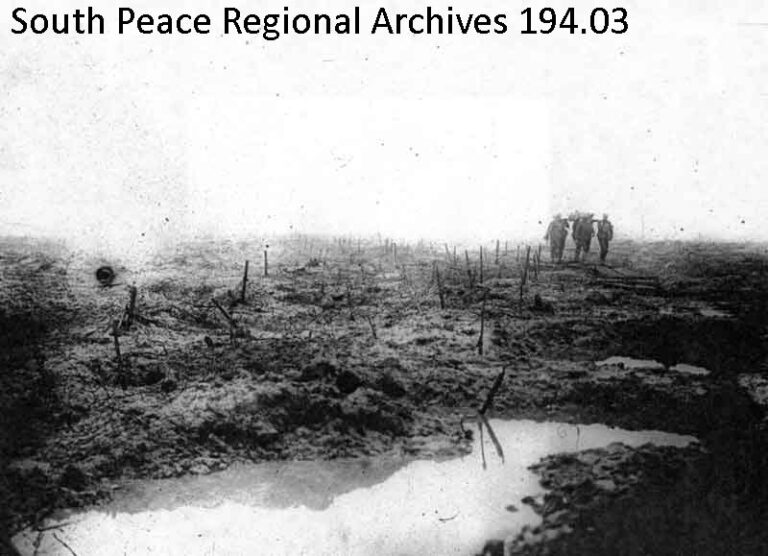After great success at Vimy Ridge and Hill 70, the Canadians were called upon to relieve the Australian and New Zealand troops in Flanders, Belgium. Many preparations were made under the careful eye of General Currie, and on October 26th the attack was launched. The Battle of Passchendaele lasted until mid-November, at the expense of 15,654 Canadian lives. Following is an except from the memoir of a South Peace soldier, Lance Corporal Edward Joseph Heller.
It seemed to be the policy then and there to have comparatively few in the front line, for if the enemy counter attacked he would probably overrun it anyway. We did some digging during the night, connecting shell holes, deepening ditches that were supposed to be trenches, etc. to make room for the extra men… The ground, as at Vimy Ridge, was all torn up. I am sure not a square foot being in its original condition or position. We suffered a few casualties during the night, subjected to what was called a harassing fire: the artillery mow and then dropping a shell here, one there. Our artillery did that too. When morning came, we settled down into the ditches… We lay where we were, in the mud of course, all day of the 29th. If one wanted to change position, get a hard tack out of the haversack, or move for any reason at all, one had to move very slowly… Of course we couldn’t move very fast anyway, as we were chilled to the bone.
There was a sort of step at the dead end of this ditch, so I sat upon the step. I probably dozed off (for we hadn’t had much sleep for some time), for the next thing I knew, I was laying in the mud up out of the ditch, in a sort of bewildered way, thinking perhaps something had happened, for it seemed the right half of my head had been shot off (how I thought I could still be alive after that?) and 72 bones (that’s about 1/3 of them, isn’t it?) were broken. Apparently a shell passed just in front of me… and exploded. How deeply I was buried or how long it took to dig me out was not thought of then, so I never found out, which never worried me any… Two fellows helped me start walking… perhaps to some dressing station… there is a flash of a few seconds of memory… there was this railway car, low sides but no top. How and why I and others were there, I didn’t know or care… Next I was lying on a stretcher in a large marquee. By evening I was in a cot, nice white sheets, hospital pyjamas so clean and dry.
Edward Heller had in fact sustained a gunshot wound to his left leg at Passchendaele. Later in the war, his right leg was also wounded. Heller survived the war and returned to his homestead near Beaverlodge.
Photograph: SPRA 194.03, from Edward Heller’s fonds, likely taken at Passchendaele
To get an idea of the devastation they fought through, consider attending the Passchendaele movie screening at the Grande Prairie Regional College on Friday October 27 at 7:00. We will also have a small display honouring our South Peace veterans who played a role in this important battle. Click here for more information on this event.
